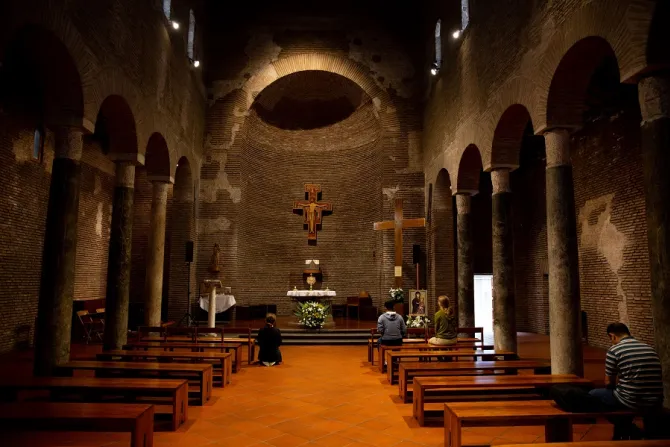Rome, Italy, Dec 17, 2018 / 11:00 am
Though it sits just steps from St. Peter's Basilica, it goes unseen by the thousands of people that pass by every day. In a city of churches, it's a church that can't be found by accident, but must be sought out. And many do.
It is St. Lawrence in Piscibus, a tiny and simple church from the 12th century, tucked behind buildings which make it undetectable from the main thoroughfare to St. Peter's Basilica.
The church has gone through many evolutions over the centuries. Eventually, it was deconsecrated and used as a study hall and sculptor's studio, until in the 1980s Pope St. John Paul II asked that it be transformed into an international youth center.
Today it has become the thriving Centro San Lorenzo, affectionately called the "Centro," where young Romans, and those passing through on pilgrimage, can stop by for prayer, Mass, and other spiritual and social activities.
As the events start up again after the summer break, now under the apostolate of the Shalom Catholic Community, the center has begun offering daily adoration and prayer for the successful work of the Synod of Bishops, taking place just minutes down the street inside the Vatican.
The Center's chaplain, Fr. Cristiano Pinheiro, said people of all kinds pass through the center and take part in a "chain of intercession," that includes Shalom missionaries, young people, priests, and even bishops attending the synod.
During the entire month of October 2018, the church held adoration of the Blessed Sacrament from 9:00 am to 5:30 pm Monday through Friday, followed by Mass at 6:00 pm; open to anyone who wanted to stop by. Two Saturdays of the month they also hosted a special program of prayer and fraternity.
Archbishop Peter Comensoli of Melbourne, who was in Rome to take part in the youth synod as a bishop delegate, said he found the church through his connection with the Shalom community.
"It's a particularly beautiful church in my mind for an Italian church," he told CNA. "It's very plain and simple and the focus is directly on the Blessed Sacrament in the sanctuary area; it's lovely."
"It's wonderful that there are people just praying, just praying for what's happening in the synod and the work that's going on here. It's a great gift," he said.
The San Lorenzo Center was founded by Pope St. John Paul II, who discovered the church of St. Lawrence in Piscibus – owned by the Vatican since 1941 – and thought it could be put to the service of youth. He reconsecrated the church with a special Mass in March 1983.
A few years later, it also became the home of the original wooden cross of World Youth Day (begun in 1985) and an icon of Salus Populi Romani, a copy of the ancient painting which hangs in the Basilica of St. Mary Major, and depicts the Blessed Virgin Mary in her title as patroness of Rome.
The small church also bears a San Damiano cross, a replica of the one hanging in the Basilica of St. Clare in Assisi, Italy, which is believed to be the cross St. Francis prayed before when he received the request from God to rebuild the Church.
One manager of Centro San Lorenzo, Jhoanna Climacosa, 27, said she finds it a "true joy," to serve in that place, which is "at the heart of the Church, at the heart of Rome, and through which pass many pilgrims from every part of the world."
Prior to its new life as a place of evangelization and welcome for pilgrims, especially youth, the church spent a few decades as a study center and the studio of artist Pericle Fazzini, who completed his large bronze sculpture of "the Resurrection" in 1977, and which stands at the back of the Vatican's Pope Paul VI hall.
The façade of St. Lawrence in Piscibus was hidden from sight when part of the area surrounding the Vatican, Rome's Borgo neighborhood, was destroyed in the late 1930s to 1940s to construct the grand thoroughfare of Via della Conciliazione, which leads up to the main square and entrance to St. Peter's Basilica.
(Story continues below)
The church was preserved from demolition, but a large palazzo was built around it, marking the start of the Pio XII Square in the style of an ancient Greek "propylaea," an architectural term which means a gateway building.
After different renovations over the centuries, one which gave it an ornate Baroque design, for structural and financial reasons it was eventually returned to what is believed to be its original, bare-stone Romanesque appearance.
Around the same years that John Paul II founded the Center, the Shalom Community was beginning in Brazil, though this is the first time their movement has been given the care of the youth center.
Cristiano knew the place from years earlier, as a seminarian studying in Rome. "Somehow I always felt connected with the church," he told CNA. "I never imagined I would come to work here and to evangelize here." His first Mass in Rome, after being ordained in Brazil, was at the Center in 2015.
"Now it's a new time, a Kairos of the youth of the Church," he said, referencing a Greek word which means "opportunity," or "a propitious moment for decision or action."
"We feel honored and we feel called by God to be at the service of the Church exactly at this time," he said, explaining that he believes there is "a very difficult spiritual war taking place right now."
"With the scandals and difficulties, God's Enemy doesn't want to see this Kairos happening in the Church. So, we need to fight against it, which we do by praying," he stated.
This article was originally published on CNA Oct. 11, 2018.



